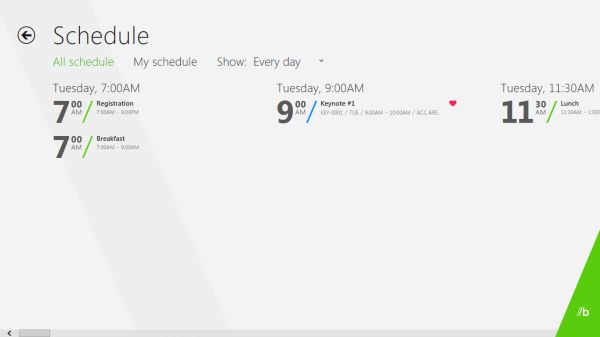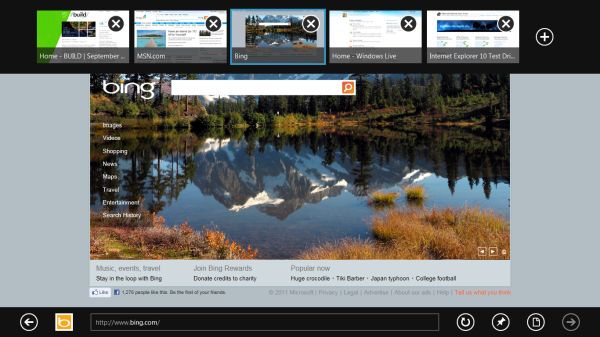Microsoft BUILD: Windows 8, A Pre-Beta Preview
by Brian Klug & Ryan Smith on September 13, 2011 12:05 PM EST- Posted in
- BUILD
- Windows
- Microsoft
- Windows 8
- Trade Shows
The Desktop User Experience & Business Use
While we’re primarily focusing on Windows 8 as a tablet OS since the hardware we used was a tablet, we also wanted to evaluate it some as a desktop OS. As the sample tablet was compatible with Bluetooth peripherals, we were able to pull out a BT keyboard and mouse and use it like a traditional laptop/desktop environment. With that said I’d like to preface our impressions with the following: as it stands Windows 8 is clearly focused on tablets first and Microsoft’s presentation was equally tablet focused, and it’s almost certain the experience will change before Windows 8 ships.
Overall Windows 8 is extremely jarring right now from a desktop user perspective. Metro is the Windows shell, no ifs ands or butts. Metro applications can only be accessed through the Metro shell (i.e. the Start Screen), and the Metro shell is always what the tablet will boot up into. Explorer as we know it is the Metro shell – if you kill it, you kill Metro shell with it – so at this time it’s not possible to boot up into the traditional Windows desktop. Even if you could, the Start Menu is gone, replaced with Metro charms.
So what we’re really evaluating is the ability to use the Metro shell and Metro applications with a mouse. For all the good Microsoft has done implementing multi-touch, the mouse has clearly suffered as it currently stands. Click & drag does not operate the same as tap & drag, which creates some oddities when you want to scroll around. In fact scrolling is probably the biggest oversight right now, as the Metro style dictates applications are laid out left-to-right rather than top-to-bottom. The mouse wheel will (slowly) scroll through tiles on the Start Screen, but in other places such as the Microsoft BUILD application the mouse wheel is useless. In its place you have to drag a scroll bar around, which is about as fun as it was prior to mice coming with a wheel.
Internet Explorer is particularly weird. Because it takes the full screen approach there isn’t a menu bar to speak of, and the tabs and URL bar are hidden. Invoking them requires right-clicking, with right-clicking pulling double duty as a way to open a link in a new tab and invoking the various bars. This also means that right-clicking for other purposes (e.g. View Source, etc) are unavailable.
The good news is that most of the traditional keyboard shortcuts still work, including Alt-Tab, WinKey + D, WinKey + E, and Ctrl-Alt-Esc. You can even Alt-Tab between launched Metro applications. The Start Menu search bar is also faithfully replicated on the Start Screen, so when you start typing Windows 8 will start narrowing down results of things to open. So overall keyboard users maintain much of their advantage in quickly executing applications. At the same time we’ve encountered fields that we can’t tab to, so not everything is working as it should.
While we’ve only had a short period of time work play with Windows 8 with a mouse and keyboard, at this point in time there’s not a lot to say that’s positive. Metro works well as a tablet interface, but with a mouse and keyboard it’s like using a tablet with a mouse and keyboard. Hopefully Microsoft will have a more suitable mouse & keyboard control scheme ready to go for Windows 8 farther down the line.
Windows 8 the Business OS
So far Microsoft has been focused on the consumer side of Windows 8, but business users won’t be left out in the cold. Windows 8 will also be the basis of a new version of Windows Server (also using Metro), and Windows 8 clients will have some new features.
The business additions announced so far for Windows 8 revolve around Remote Desktop and Hyper-V. Windows 8 Remote Desktop includes proper support for multi-touch controls, so tablets and other touch devices will be able to RDP into other machines and correctly interact with them. Meanwhile Windows 8 will add support for Hyper-V (previously it was Server-only), allowing Windows clients to spawn virtualized instances of Windows through the Hyper-V hypervisor.
Microsoft also used their discussion on the business side of Windows 8 to announce that Windows 8 will support installation onto and booting off of a USB drive, allowing business users to carry their copy of Windows with them. This has been a repeatedly requested feature for many years from more than just business users, so hopefully it will be everything everyone has always wanted.












235 Comments
View All Comments
TEAMSWITCHER - Wednesday, September 14, 2011 - link
I'm sure it will be successful as all the other METRO GUI devices - Zune, Kin, WP7.Oh Snap!
UMADBRO - Wednesday, September 14, 2011 - link
Cool story, bro!Wraith404 - Thursday, September 15, 2011 - link
Hey, at least 100 people have accepted free WP7 phones.Krussll - Wednesday, September 14, 2011 - link
I like it, i think the Metro interface wil provide a much more harmonious windows experience for people who've adopted tablet computing but still use a windows PC for the most of their. I like the fact that it provides you with your key info on start up and is a short cut combo away when you need to check it, i think it has potential to be a great feature if developers can fully utilize it.I dont understand the people saying that it will be impractical for the mouse, umm you do have arrow keys on your keyboard i would have though that would have been obvious to use them.
thrasher32 - Wednesday, September 14, 2011 - link
I personally do not like the interface. I don't want a windows phone 7 look or OS on my desktop. I don't build $2000 gaming and production rigs to have the OS look like it's made for a 5 year old.Microsoft, you need to change direction now or you're looking at another Vista.
UMADBRO - Wednesday, September 14, 2011 - link
opinions = facts?smithg5 - Wednesday, September 14, 2011 - link
Take all of these purely negative comments, and replace "Metro" with "Desktop" and "Desktop" with "Command Line", and I'm sure you could have had the exact same conversation 15 years ago."You mean I always have to boot the desktop? It can't be disabled? I have to access the CLI from the desktop? Why would I use this on a server?"
The argument might be logical, but it clearly wasn't the end of the world then, and it won't be the end now. In fact, I think it's pretty great. Imagining system administration in 20-30 years, we all want some sort of swoopy sci-fi interface that's pretty and works well - this is the start of that.
It would be cool if they could Metrofy server management for simple environments.
UMADBRO - Wednesday, September 14, 2011 - link
At least someone around here is forward thinking and isnt stuck on almost 20 year old interfaces.Wraith404 - Thursday, September 15, 2011 - link
full screen, big blocks with no interactive multi-tasking is not forward thinking, it's a return to DOS 6.22 and the task swapper.Trying to drive desktop users to a tablet interface is doomed to fail. Windows are containers, they are required for productivity. In grown up land where we do real work, you often have to look at one application and act on another. Flipping between them in full screen would be horribly inconvenient. Metro might be neat, but it's for toys, period. I understand that Win8 can switch between them, but since the two modes clash horribly that's just not a desirable process. I have the preview installed, and disabled Metro already, simple as that.
ezodagrom - Wednesday, September 14, 2011 - link
The change from Command Line to Desktop was a good change, not just when it comes to aesthetics, but also when it comes to funcionality (multitasking).The change from Desktop to Metro, while good for tablets and other touch screen interfaces, it's just not as functional as a Desktop UI in desktops and laptops that don't have touch screen interfaces, especially when it comes to multitasking.